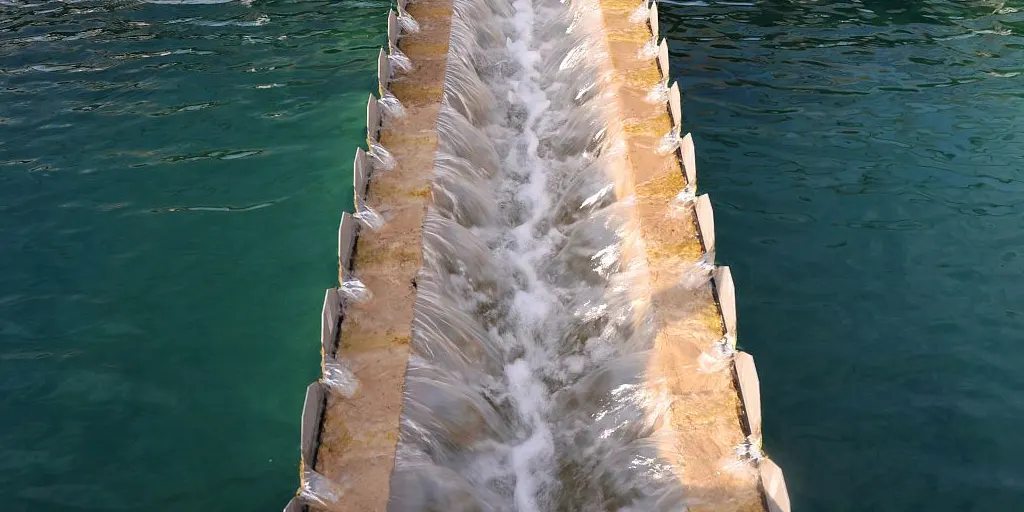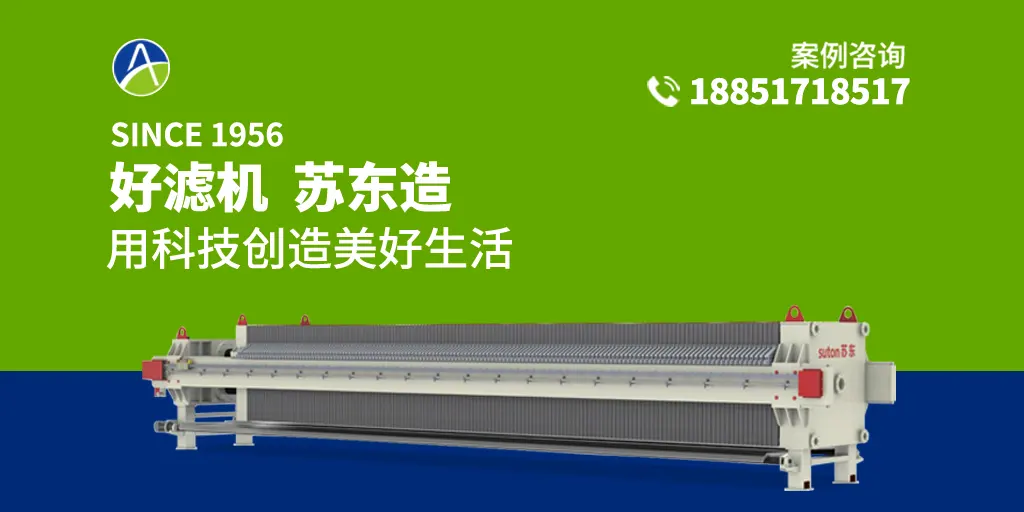introductory
根據(jù)國家住房和城鄉(xiāng)建設(shè)部統(tǒng)計(jì)數(shù)據(jù),全國設(shè)市城市、縣累計(jì)建成城鎮(zhèn)污水處理廠2832座,污水處理能力達(dá)到1.25m3/d.污水處理廠的污泥是各類污水處理過程中的必然產(chǎn)物,含水率較高,體積大,按上述規(guī)模計(jì)算,全國每日至少約要產(chǎn)生含水率為97%的污泥約70萬t。
污水處理過程中產(chǎn)生的污泥,其脫水減量化處理是后續(xù)處理處置的經(jīng)濟(jì)性的前提和保證。為降低含水率,達(dá)到污泥處置對含水率的要求,目前,較多的城鎮(zhèn)污水處理廠選用Plate and frame filter presses來對產(chǎn)生的剩余污泥進(jìn)行脫水,降低污泥含水率。
污泥深度脫水是指對污泥進(jìn)行調(diào)理,破除細(xì)胞壁,釋放結(jié)合水、吸附水和細(xì)胞內(nèi)水,改善污泥的脫水性能,使處理后的污泥含水率達(dá)到60%以下的脫水方式。針對不同的城市污水處理廠污泥性質(zhì)和后處理處置要求,利用過Filter Press Plate、隔膜板和濾布組成的過濾單元,在油缸壓緊濾板的條件下,用進(jìn)料泵壓力對物料進(jìn)行固液分離,并在進(jìn)料結(jié)束后,采用隔膜壓榨技術(shù)對濾餅進(jìn)行壓榨,顯著提高壓濾機(jī)的脫水效率,濾餅較硬,呈塊狀,主要設(shè)備為板框壓濾機(jī)。濾布是板框式壓濾機(jī)的“心臟”,板框式壓濾機(jī)的過濾效果主要決定于所選的濾布是否恰當(dāng),合適的濾布壓濾過程中產(chǎn)生濾液澄清,固相損失少,壓濾后濾餅容易剝離,濾布不易堵塞,容易反洗再利用,工作壽命長。

因此,合理選用濾布,提高過濾效率,降低脫水后污泥含水率,降低生產(chǎn)成本,是板框式壓濾機(jī)選配的一項(xiàng)重要任務(wù)。
Filter press cloths are classified and selected according to the selected cloth material, the way the material is constructed, and the way it is prepared.
1.1濾布材質(zhì)
1.1.1 Polypropylene filter cloth
丙綸是由丙烯作原料經(jīng)聚合、熔體紡絲制得的纖維,價格較為低廉。丙綸濾布具有較好的耐化學(xué)腐蝕性,對酸和堿抵抗性能良好,力學(xué)強(qiáng)度高,耐磨性好。丙綸的濕強(qiáng)基本等于干強(qiáng),在進(jìn)泥后壓濾過程中,丙綸濾布強(qiáng)度基本保持不變。丙綸濾布的吸濕性很小,幾乎不吸濕,一般大氣條件下的回潮率接近于零,但它有芯吸作用,能通過織物中的毛細(xì)管傳遞水蒸氣,但本身不起任何吸收作用。丙綸的縱面平、直、光,在污泥壓縮后,也便于污泥的剝離。但丙綸濾布的耐光性較差,熱穩(wěn)定性也較差,易老化⑷。
1.1.2 Polyester filter cloths
Polyester is a fibre-forming polymer - polyethylene terephthalate (PET) - made from purified terephthalic acid (PTA) or dimethyl terephthalate (DMT) and ethylene glycol (EG) by esterification or ester-exchange and polycondensation reactions, and then made into fibres by spinning and post-treatment. Polyester has high strength, good abrasion resistance, good light resistance, corrosion resistance, resistance to bleach, oxidants, cones, ketones, petroleum products and inorganic acids, resistance to dilute alkali, not afraid of mildew, but the hot alkali can be made to decompose.
Due to the low moisture absorption of polyester filter cloth, its wet strength is basically the same as its dry strength. The elasticity is close to that of wool, and it can be almost fully recovered when elongated 5%-6%. Wrinkle resistance exceeds that of other fibres, i.e. the fabric is not wrinkled and has good dimensional stability.
1.1.3 Nylon filter cloth
Nylon fibre high strength, strength of 4 ~ 5.3Cndtex, elongation of 18% ~ 45%. 10% elongation elasticity in the same rate of 90% to ± o nylon strength in the strongest fibres, it is measured, nylon fibre abrasion resistance of cotton fibre 10 times, 50 times viscose. Abrasion resistance is the first of a variety of fibres. Nylon fibre is resistant to strong alkali and weak acid. However, nylon is not resistant to light, easily discoloured and brittle, so nylon fabrics should not be exposed to sunlight for a long time.
1.1.4 Vinylon filter cloth
Vinylon filter cloth chemical name is called polyvinyl alcohol, its strength is lower than polyester, strength is only 3.52~5.72Cndtex. breaking elongation 12%~25%. elasticity is poor, the fabric maintains the shape of the poor, better abrasion resistance, durability is 1~2 times more than pure cotton. But there is a big advantage is able to withstand the role of strong alkali, and moisture absorption is good, easy to combine with the rubber, is a good material for the rubber industry, it is a disadvantage of lower temperature resistance, the temperature up to 100 dragons on the contraction of the acid is not resistant.
| a meter (measuring sth)1Performance indicators of different material filter clothsTab.1PerformanceofDifferentMaterial | ||||
| performances | polyester fibre | nylon | polypropylene fiber | (loanword) vinylon, synthetic fiber made from polyvinyl alcohol |
| acid resistance | vigorous | mediocre | favourable | acid-intolerant |
| alkali resistance | alkali-resistant | favourable | vigorous | alkali |
| responsiveness | an excellent | preferably | an excellent | mediocre |
| abrasion resistance | an excellent | an excellent | (of an unmarried couple) be close | preferably |
1.2 Filter cloth material structure
According to the structure of the filter cloth material can be divided into: monofilament, compound filament long fibre and staple fibre.
Monofilament is generally a synthetic fibre pulled into a single filament of 0.16-0.32dtex, the filter cloth woven by it has the advantages of smooth surface, uniform void, small specific resistance, fast water permeability, not easy to block, easy to clean and good sludge stripping performance. However, it traps particles of larger diameter, the filtrate has a higher solid rate and a lower recovery rate.
Compound filament, i.e. warp/weft, consists of multiple fibres woven into a single filament. Compound filament long fibre woven into filter cloth with it, good tensile strength, the retention of particles is better than monofilament, but the sludge unloading peeling performance is slightly worse.
Complex filament staple fibre is made of natural cotton wool fibre or synthetic staple fibre twisted into multiple strands, which has a fluffy fibre, presenting good particle retention performance, good sealing, but the disadvantage is that the pores are easy to clog, cleaning and sludge stripping performance is poor.
| a meter (measuring sth)2Characteristics of several common structural forms of filter cloths
Tab.2CharacteristicofServalCommonStructionFilters |
||
| material (that sth is made of) | filament | filament |
| polypropylene fiber | Polypropylene long fibre, the fibre is long, the formation of the yarn is smooth, and polypropylene long fibre woven into the industrial fabric, the cloth surface is smooth, breathable performance is good. | Polypropylene staple fibre, short fibre, spun yarn with hair; so polypropylene staple fibre woven into industrial cloth, cloth surface with hair, powder filtration and pressure filtration effect is better than long fibre. |
| polyester fibre | Polyester long fibre filter cloth has smooth surface, good abrasion resistance, high strength, higher strength and better abrasion resistance through twisting, thus the fabric has good air permeability, fast water leakage and easy cleaning. | Polyester staple fibre filter cloth raw material structure is short and hairy, woven fabrics are dense, particle retention is good, but peeling, air permeability is poor. Strength and abrasion resistance, water leakage is not as good as polyester long fibre filter cloth. |
1.3 Filter cloth preparation
According to the weaving method of filter cloth can also be divided into three kinds: plain, twill and satin.
Plain filter cloth has dense structure and small pores, so it has good particle retention, high filtrate clarification, long service life and cheaper price. The disadvantage is that the specific resistance is large, easy to clog, and the performance of slag discharge is poor.
Satin weave fabric has the largest pores, small specific resistance, not easy to plug, good sludge stripping performance. However, the particle retention capacity is low, the filtrate is turbid, and the recovery rate is low.
The performance of twill filter cloth is between plain and satin, but it is widely used because of its strong friction resistance, high filtration speed and longest life.
Requirements for filter cloth of plate and frame filter presses for urban wastewater treatment plants
Urban sewage treatment plant sludge production is larger, the work intensity is higher, the filter cloth is often used repeatedly extrusion, need to have a certain tensile strength, no stretch, good dimensional stability, the mechanical strength of the filter cloth requirements are higher; in the sludge conditioning and tempering process is often required to add PAM, iron salts, aluminium salts or lime and other agents, the sludge nature of the sludge is more complex, the sludge is alkaline after the conditioning, the filter cloth should be able to have a certain degree of Corrosion resistance.
Urban sewage treatment plant sludge is mainly organic particles, fine particles, the need for relatively small pore filter cloth, filtration filtrate to be clearer, conducive to improving the recovery rate of sludge; filter cloth permeability is also good, fast filtration speed, faster discharge of water out of the sludge, to improve the efficiency of the plate and frame machine; filter cloth should not be clogged; filter cloth dewatering of sludge after the stripping of the good, the mud cake in the plate and frame machine can be automatically stripped after the opening of the frame; easy to rinse the regeneration, to extend the use cycle, reduce the cost of using the cloth. The filter cloth is easy to be washed and regenerated, which prolongs the use cycle and reduces the use cost.
Therefore, in the plate and frame filter press cloth selection, to be able to meet the following requirements: high strength, corrosion resistance, filtrate clear, fast water permeability, not easy to plug, easy to peel, long life.
3Analysis of test data
According to the actual processing experience, for the above requirements, combined with the characteristics of the material, urban wastewater treatment plant plate and frame filter press dewatering machine filter cloth should be used for polypropylene or polyester filter cloth, the material composition of the selection of monofilament or filament filament long fibre, the preparation of choice of commonly used twill pattern, and will be the two kinds of filter cloth for testing and comparison, as shown in Table 3.
| Filter cloth number | material (that sth is made of) | framework | Presentation |
| 1# Filter Cloth | polypropylene fiber | multifilament long fiber | twill |
| 2# Filter Cloth | Polyester Unity; | monofilament | twill |
A plate and frame filter press with a filtration area of 4 n? was used in the test, the maximum pressing pressure was 15 kgf and the maximum closing pressure was 12 kgf, and two types of filter cloths as shown in Table 3 were used to analyse the sludge treatment under the conditions of different concentration of chemicals and different types of chemicals.
The sludge used for the test was the thickened sludge from the Shidongkou Sewage Treatment Plant, and the chemicals used were fly ash from sludge drying and incineration, ferric chloride and cationic polyacrylamide.
3.1 Effect of different agents on the water content of filter fabrics
The test selected the common types of chemicals added, combined with the selection of plate and frame filter presses under different filter cloth conditions, water content and other conditions of the analysis," as shown in Table 4.
| batches | Water content of feed mud/% | Proportion of dosage | press-fit (e.g. seam sealing) | extract juice, oil etc by squeezing | –Cloth_Filter Type– | Cake moisture content
/% |
||||
| fly ash
/% |
carnallite (hydrated potassium magnesium chloride mineral)
/% |
PAM
(+)/% |
Pressure/kgf | Time/min | strains
/kgf |
Time/min | ||||
| 1 | 97.2 | 10.0 | 0 | 0.015 | 11.5 | 90 | 15 | 60 | 1# Filter Cloth
2# Filter Cloth |
78.1
79.7 |
| 2 | 97.3 | 0 | 7.0 | 0 | 11.5 | 90 | 12 | 60 | 1# Filter Cloth
2# Filter Cloth |
69.6
68.5 |
| 3 | 97.1 | 20.0 | 8.0 | 0.014 | 11.5 | 90 | 12 | 60 | (Cant.) plural for pronouns
2 luminescent cloth |
65.9
65.3 |
From the water content of the mud cake, without adding iron salt, the water content of the mud cake of 2# filter cloth is higher than that of 1# filter cloth, and after adding iron salt, the water content is obviously reduced, and the water content of 2# filter cloth is lower.
3.2 The effect of different dosage on the water content of the filter cloth
The test selected in the iron salt dosage fixed, fly ash dosage changing conditions, two filter cloth filtration after the water content of the situation shown in Table 5.
From Table 5, it can be seen that due to the better water permeability of the 2# filter cloth, the reduction of water content is particularly obvious with the increase of the concentration of fly ash injection.
| batches | Water content of feed mud/% | Proportion of dosage | press-fit (e.g. seam sealing) | extract juice, oil etc by squeezing | -Types of filter cloth | Cake moisture content
/% |
||||
| fly ash
/% |
carnallite (hydrated potassium magnesium chloride mineral)
/% |
PAM
(+) |
strains
/kgf |
Time/min | Pressure/kgf | Time/min | ||||
| 1 | 97.0 | 25.0 | 7.0 | 0 | 11.5 | 90 | 12 | 60 | 1# Filter Cloth
2# Filter Cloth |
65.1
65.2 |
| 2 | 97.4 | 30.0 | 7.0 | 0 | 11.5 | 90 | 12 | 60 | 1# Filter Cloth
2# Filter Cloth |
57.5
55.9 |
| 3 | 97.1 | 45.0 | 7.0 | 0 | 11.5 | 85 | 12 | 60 | 1# Filter Cloth
2# Filter Cloth |
53.5
52.1 |
3.3 Comparative analysis
Combining the above test results, a comparative analysis of the two filter cloths is shown in Table 6.
| a meter (measuring sth)62Indicators for the evaluation of filter clothsTab.6Performanceof2Filters | ||
| Evaluation indicators | 1# Filter Cloth | 2# Filter Cloth |
| Dehydrated moisture content | your (honorific) | lower (one's head) |
| turbid filtrate | surname Qing | impure |
| Automatic shedding | differ from | (of an unmarried couple) be close |
| permeability | (following a decimal or fraction) slightly less than | vigorous |
reach a verdict
With the growth of urban population, the continuous improvement of municipal services, sewage treatment technology innovation and the deepening of the degree of treatment, the amount of sludge produced in the process of sewage treatment will increase greatly, sludge dewatering and reduction is imperative, plate and frame machine as a more commonly used treatment equipment, the development prospects are broader.

The selection of filter cloth for plate and frame machine is very important, which needs to be considered comprehensively with a number of factors such as filtrate, water content of sludge cake, and the cost of use, etc. While summarising the nature of sludge and the characteristics of the treatment process of municipal sewage treatment plant, two commonly used filter cloths were selected for the experimental study, and the results showed that the polyester monofilament twill filter cloth was able to get a lower water content, but the filtrate was more turbid, and the recovery rate of the sludge dewatering was lower, while the Polypropylene compound filament twill filter cloth has a higher water content, but the filtrate recovery is good. Each sewage treatment plant can choose the appropriate filter cloth according to its own situation, to achieve the purpose of reducing the water content and improving the efficiency of use.
Technical: 188517-18517
E-mail: suton@su-ton.com
 Plate and frame chamber diaphragm filter presses
Plate and frame chamber diaphragm filter presses






